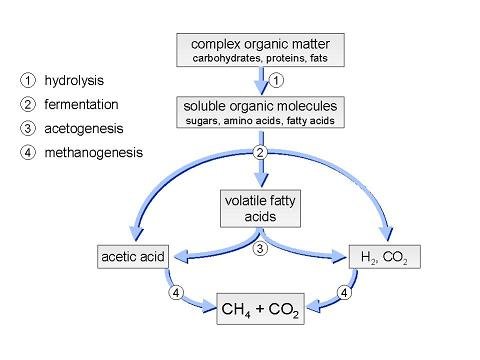Anaerobic Digestion
Anaerobic digestion is a complex biochemical reaction carried out in a number of steps by several types of micro-organisms that require little or no oxygen to live. During the process, a gas principally composed of methane (CH4) and carbon dioxide (CO2), known as biogas, is produced. The amount of gas produced varies with the amount of organic waste fed to the digester and temperature influences the rate of decomposition (and gas production).

- Hydrolysis: complex organic matter is decomposed into simple soluble organic molecules using water to split the chemical bonds between the substances.
- Fermentation or acidogenesis: the chemical decomposition of carbohydrates by enzymes, bacteria, yeasts, or molds in the absence of oxygen.
- Acetogenesis: the fermentation products are converted into acetate, hydrogen and carbon dioxide by so-called acetogenic bacteria.
- Methanogenesis: methane (CH4) is formed from acetate and hydrogen/carbon dioxide by methanogenic bacteria
The acetogenic bacteria grow in close association with the methanogenic bacteria during the fourth stage of the process. The reason for this is that the conversion of the fermentation products by the acetogens is thermodynamically only possible if the hydrogen concentration is kept sufficiently low. This requires a close symbiotic relationship between both classes of bacteria.
Anaerobic treatment produces between five and ten times less biosolids (sludge) than aerobic processes.
In addition, anaerobic biosolids have the advantage of being much more compact than aerobic biosolids. The dry solids content of anaerobic biosolids range from 2% (for a digester) to more than 8% for an upflow anaerobic biosolids blanket process.

